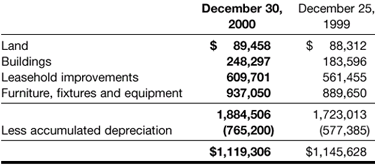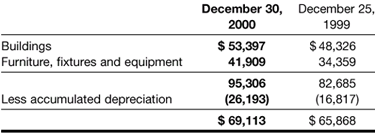|

In 1999, we recorded
facility closure charges of $40.4 million to reflect our decision to accelerate
our store closure program for under-performing stores and our relocations
program for older stores in our North American Retail Division. These
charges consisted of asset write-offs ($29.2 million), residual lease
obligations ($8.3 million) and other exit costs ($2.9 million).
Note
D—Other One-time Charges and Adjustments
The comprehensive
review discussed in Note C
above had the following additional financial impacts:
- Inventory—$25.6
million (included in cost of goods sold), representing a write-down
to net realizable value of inventory in stores and CSCs that is being
eliminated from our merchandise assortment. This will allow us to focus
on our core business customer, reduce complexity, and provide better
customer service by having better “in stock” positions on
products that customers buy most often.
- Property and equipment—$74.2
million ($63.0 million included in store and warehouse operating and
selling expenses and $11.2 million included in general and administrative
expenses), representing impairment of assets in our closing stores and
the write-off of old signage and obsolete technology-related assets.
- Investments—$45.5
million (included in miscellaneous income (expense)), representing a
reduction in the value of certain Internet investments. These holdings
are primarily businesses that are privately held and are involved in
marketing partner-ship agreements with Office Depot. Because quoted
market prices for these privately held businesses are not available,
we determined the current value of our investments in these businesses
by analyzing their financial position and plans, industry valuation
indices, current economic conditions including liquidity, and the current
market for Internet companies.
- Goodwill—$11.1
million (included in miscellaneous income (expense)), representing impairment
of goodwill associated with the acquisition of our Japanese operations.
The Office Depot Japan retail operations have not performed to expectations.
A new operating model and significant additional investments will be
necessary to enable the current stores to achieve profitability, which
may never occur even with the model changes and capital infusion.
- Sales returns and
allowances—$10.5 million, net (comprised of a reduction of sales
of $42.8 million partially offset by a reduction of cost of goods sold
of $32.3 million), to establish a reserve for sales returns and allowances
(prior periods were not restated because of the insignificance to prior
years’ financial results and retained earnings).
- Severance—$35.6
million ($33.9 million included in general and administrative expenses
and $1.7 million included in store and warehouse operating and selling
expenses), representing severance relating to changes in executive management
and a reduction in our contract sales force.
Also included in the
results of operations for 2000 is a gain on the sale of certain investments
of approximately $57.9 million. This gain is included in miscellaneous
income (expense) on our Consolidated Statements of Earnings.
In 1999, we increased
our provision for slow-moving and obsolete inventories in our warehouses
and stores by $56.1 million. This charge was primarily related to slow-moving
technology-related products whose market values were adversely affected
by accelerated rates of change in technology; and a rationalization of
the warehouse inventory assortments in conjunction with the Viking warehouse
consolidation.
Also in 1999, we changed
our method of accounting for revenue generated from sales of extended
warranty service plans. Under the laws of certain states, we are obligated
to assume the risk of loss associated with such plans. In these states,
we modified our accounting to recognize revenue for warranty service contract
sales over the service period, which typically extends over a period of
one to four years. In those states where we are not the legal obligor,
we modified our accounting to recognize warranty revenues net of the related
direct costs. This change resulted in a reduction in our 1999 gross profit
of $15.8 million.
Note
E—Property and Equipment
Property and equipment
consisted of:

The above table of
property and equipment includes assets held under capital leases as follows:


|